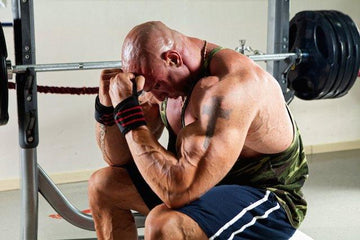

How Many Sets to Get Bigger and Stronger?
Table of Contents
| Exercise | Sets | Reps |
| Back Squats | 8-12 | 5-20 |
| Hack Squats | 5 | 10-15 |
| Leg Extension | 5-8 | 10-15 |
| Leg Curls | 6-10 | 10-15 |
| Standing Calf Raises | 3-4 | 10-15 |
| Seated Calf Raises | 3-4 | 10-15 |
| Hack Machine Calf Raises | 3-4 | 10-15 |
How Many Sets to Get Bigger and Stronger?
According to a study published this month in the Journal of Strength and Conditioning Research, multiple sets are superior for increasing muscle mass.
You may not think that this leg workout is humanly possible, but its the original leg workout of the bodybuilder who had some of the greatest legs in the history of bodybuilding, Tom Platz. With this particular routine, for example, you’re going to be performing between 33-47 sets a session. While some bodybuilders perform much less sets, there are some that advocated one set to failure such as Dorian Yates. Dorian believed in doing a few warm up sets and then one heavy set to complete muscular failure. So what does the science of muscle hypertrophy and number of sets suggest? Some studies show that there’s no difference between 1 and 3 sets, whereas others studies show that 3 sets is better than 1 set. According to a study published this month in the Journal of Strength and Conditioning Research, multiple sets are superior for increasing muscle mass.
The results demonstrate a dose-response for the number of sets per exercise and a superiority of multiple sets compared with a single set per exercise for strength gains, muscle endurance, and upper arm muscle hypertrophy.
Researchers compared the response of performing 1, 3, and 5 sets on measures of performance and muscle hypertrophy. Forty-eight men, with no weight training experience, were randomly assigned to one of the 3 training groups, 1 SET, 3 SETS, 5 SETS, or control group. All training groups performed 3 resistance training sessions per week for 6 months. All exercises were performed with a weight of 8-12RM (meaning the subjects failed after 8-12 reps) and a rest interval of 90 to 120 seconds between sets and exercises. The training resistance was increased by 5-10% for the next session when subjects were able to perform more than 12 repetitions in all sets of an exercise. At the end of the study, the 5 repetition maximum for all training groups increased in the bench press, front lat pull down, shoulder press, and leg press, with the 5RM increases in the bench press and front lat pull down being significantly greater for 5 SETS compared with the other training groups. Bench press 20 repetition maximum in the 3-SET and 5-SET groups significantly increased with the increase being significantly greater than the 1-SET group and the 5-SET group increase being significantly greater than the 3-SET group. Leg Press 20 repetition maximum increased in all training groups, with the 5-SETS group showing a significantly greater increase than the 1-SET group. The 3-SET and 5-SET groups significantly increased elbow flexor muscle thickness with the 5-SET increase being significantly greater than the other 2 training groups. The 5-SET group significantly increased elbow extensor muscle thickness with the increase being significantly greater than the other training groups. All training groups decreased percent body fat, increased fat-free mass, and vertical jump ability, with no differences between groups. The results demonstrate a dose-response for the number of sets per exercise and a superiority of multiple sets compared with a single set per exercise for strength gains, muscle endurance, and upper arm muscle hypertrophy.
This study supports the use of more sets to increase strength gains and muscle endurance, although I am not sure why the 5 set group had greater gains in upper arm hypertrophy and there was no difference in muscle growth of the other body-parts. It would be wise to vary the number of sets (i.e. training volume), load (i.e. weight), exercise selection, exercise order, rest intervals, etc.
Radaelli R, Fleck SJ, Leite T, Leite RD, Pinto RS, Fernandes L, Simão R.
Dose-response of 1, 3, and 5 sets of resistance exercise on strength, local
muscular endurance, and hypertrophy. J Strength Cond Res. 2015 May;29(5):1349-58.
Bottaro, M et al. Resistance training for strength and muscle thickness: effect of number of sets and muscle group trained. Science and Sports 26: 259-264, 2011.
Hass CJ, Garzarella L, de Hoyos D, Pollock ML: Single versus multiple sets in long-term recreational weightlifters. Med Sci Sports Exerc 2000, 32:235-242.
Rhea MR: Determining the magnitude of treatment effects in strength training research through the use of the effect size. J Strength Cond Res 2004, 18:918-920.
Kraemer WJ, Ratamess N, Fry AC, Triplett-McBride T, Koziris LP, Bauer JA, Lynch JM, Fleck SJ: Influence of resistance training volume and periodization on physiological and performance adaptations in collegiate women tennis players. Am J Sports Med 2000, 28:626-633.
Paulsen G, Myklestad D, Raastad T: The influence of volume of exercise on early adaptations to strength training. J Strength Cond Res 2003, 17:115-120.
Rhea MR, Alvar BA, Ball SD, Burkett LN: Three sets of weight training superior to 1 set with equal intensity for eliciting strength. J Strength Cond Res 2002, 16:525-529.
MUSCLE MEDIA MAGAZINE FOR MEN
The premier source of training, nutrition, supplements, fat loss and health for men.

















